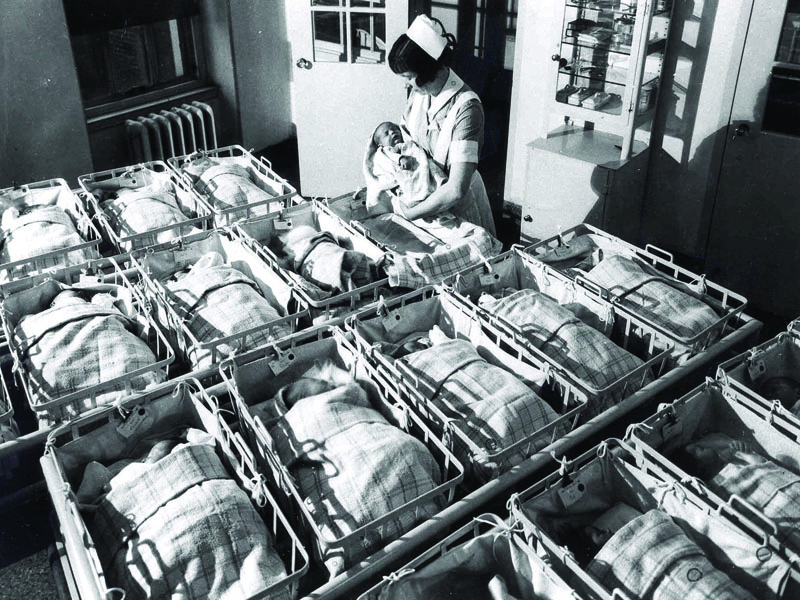Women are often drowning in information on labour but miss out on advice on sleep disturbance
Maternal sleep disturbance after childbirth is a universal experience, yet like many of the unexpected “surprises” of having a baby, it is not often emphasised by health professionals.
The usual pre-natal emphasis is on labour and breastfeeding, rather than the impact of a new baby on the sleep pattern of the parents, so parental expectations can often be unrealistic.
Many factors affect the quality and quantity of sleep obtained by new mothers. These include maternal age, the delivery experience, the number of children in the household, infant temperament, and feeding and overnight support.
Attendant hormonal changes can also play a role, such as a drop in oestriol and progesterone, and the rise of oxytocin and prolactin, which fluctuate with lactation.
The secretion of melatonin – the hormone that helps regulate sleep and wakefulness – may also undergo changes during this time, including higher baseline levels and lower percentage rise, suggesting altered circadian rhythms. On average, breastfeeding mothers are awake longer during the night in the month following delivery, but by three months are sleeping longer than formula-feeding mothers, with increased slow-wave (deep) sleep, a tendency to sleep later into the morning hours (which may alter circadian rhythms), and increased daytime sleepiness.
This article seeks to address some of the sleep-related issues facing women in the postpartum period, which go beyond infant feeding, settling and routines. The role of many partners in attending to infant care overnight should also be acknowledged, and we must remember they face sleep disturbance of their own, along with resulting daytime consequences.
Maternal sleep
In 2010 a North American study1 aimed to establish what a normal sleep pattern looked like in the first four months postpartum, in predominantly white, non-depressed, socioeconomically diverse women. On average, the women slept just over seven hours at night. The duration of sleep remained constant, but the sleep was very fragmented, with two total hours of wakefulness on average every night. This was largely related to infant feeding and sleeping schedules.
The authors suggested that this sleep fragmentation can be considered part of a “normative developmental period”, however acknowledged its role in daytime sleepiness, decreased cognitive performance and lowered executive functions, and implications for safety and quality of life.
Optimising modifiable factors may help to decrease the degree of maternal sleep disruption. Other potential contributors to sleep fragmentation are pre-existing maternal insomnia or other sleep disorder (such as obstructive sleep apnoea), anxiety and depression.
Sleep fragmentation
The cumulative effect of sleep fragmentation in the first four months has been shown to lead to impairments equivalent to those seen after one night of total sleep deprivation. The resulting neurobehavioral impairment to attention and rapid response time is equivalent to a 0.10% blood-alcohol concentration, twice the legal limit in Australia5.
In one study, Insana and colleagues6 showed that despite improvements in postpartum sleep over a 12-week period, maternal neurobehavioral performance, measured by the Psychomotor Vigilance Test, did not improve as the sleep pattern improved.
The authors concluded this may have been due to the cumulative effects of sleep disturbance, with clear implications for driving safety and other high-risk activities.
Importantly, maternal sleep disturbance can be a precipitating factor for postpartum depression, particularly if sleep duration is less than six hours per 24 hour period2. The study examined relationships among infant sleep patterns, maternal fatigue and development of depressive symptomatology, and found that after the second postpartum week, less than 50% of women napped at least once each week. This would suggest that many women aren’t able to “sleep while the baby sleeps” and need more than old-fashioned advice to prevent fatigue.
Insomnia and depression
As mentioned above, some women have difficulty falling asleep even when there is the opportunity to do so. The risk of postpartum insomnia is higher for women with a past history of insomnia and for those experiencing anxiety or depression. Postpartum depression affects 10% to 15% of women, and can be characterised by difficulty sleeping while the baby is sleeping at night, and fears about hurting the baby.
Women with a history of sleep disruption in the third trimester and those who labour at night are at increased risk of depression8,9. Sleep disturbance also contributes to postpartum mood changes, especially if sleep duration in a 24-hour period is less than six hours or there are three or more overnight awakenings.
Mirroring the findings of the 16-week study in US, Australian researchers3 measured sleep duration at six, 12 and 18 weeks postpartum and found it remained constant at seven hours.
The study also found the frequency of night-time awakenings remained constant, but duration became shorter, so there was a significant reduction in sleep disruption over time. Subjective sleepiness was shown to correlate with sleep quality (more fragmentation equals more sleepiness) rather than duration. Subjective sleepiness scores reduced significantly over time.
However, the bad news is that during week 18, by the time many women must return to work, over 50% of mothers still experienced excessive daytime sleepiness (Epworth Sleepiness Score ?12). New mothers, who may not be aware of the extent and consequences of sleep disruption, could benefit from education on maximising quality of sleep and minimising sleepiness – without putting any pressure on the new mothers to “get sleep right” as well as getting everything else right.
Practical advice
Forewarned is forearmed, so discussing sleep health with women in their third trimester can be useful. The recommendation for a whooping-cough booster in the third trimester has added another opportunity to do this.
Third trimester advice may include the following:
• Healthy sleep habits –bedroom should be mainly used for sleeping / intimacy; exercise daily; avoid electronic screens for an hour before bedtime
• How to avoid prolonged overnight awakenings –avoid excessive stimulation when waking for feeds, use relaxation techniques to get back to sleep
• Pre-plan settling strategy for baby – consider whether you will use swaddling, dummy, white noise, recommended books for advice
• Pre-plan chaos minimisation strategy – minimise visitors, maximise home help, mobilise friends to create meal delivery roster, online grocery shopping, outsource cleaning for the first few weeks
• Education about the extent of sleep disruption and its potential daytime effects – be cautious about driving in the first six weeks, and avoid when particularly drowsy
• Consider dietary choices and avoid caffeine if breastfeeding.
Confusion, hubbub and order
A recently published study4 sought to examine the relationship between maternal sleep and wake disturbance, fatigue and depression as well as the influence of infant sleep characteristics and the home environment on these variables.
The hypothesis was that household chaos, such as noise, clutter, lack of routine, and disorganisation, may be a factor influencing maternal sleep and its consequences. The study looked at forty-two healthy mother-infant dyads at infant age of 32 weeks. Among other measures, the study used the Confusion, Hubbub, and Order Scale (CHAOS) to assess routine and organisation in the home environment.
The study found that at 32 weeks postpartum, the outcomes of maternal sleep and wake disturbance, fatigue, and depression are highly interrelated. However, infant sleep pattern was not the primary factor contributing to the maternal outcomes. Instead, organisation of the home environment was a powerful contributing factor. This is eminently modifiable and can be used as part of sleep-enhancing advice.

Strategies
• Ask about sleep/night-time at early postnatal visit
• Ask about the details of night time feeds, e.g. whether the lights are on, whether smartphones and other electronic devices are used, what happens after the baby is fed
• What happens/what do you do when you can’t fall asleep?
• Impact on daytime function
• Warn about early impairments related to sleep deprivation and advise on safe driving
• Mindfulness meditation – the free Headspace app can be used for 10 minutes each day
• Digital cognitive behavioural therapy for insomnia on sleepio.com
Overnight feeding
The breastfeeding mother doing two-hourly feeds overnight may feel extremely sleepy, and may fear falling asleep while holding the baby.
Light stimulation can help manage this situation when another caregiver is not able to provide assistance. For example, the mother might feed in the loungeroom with the light on, while watching TV. When the baby has established their circadian rhythm, feeding using a night light in the baby’s room without watching TV or using a phone is preferable.
For women who prefer to feed lying down but often feel sleepy, falling asleep and smothering the baby can become a serious concern. Feeding in a chair with some light stimulation, may
be appropriate, as may another caregiver helping with these feeds.
Safety advice about co-sleeping and bed-sharing is also important. Bed-sharing, especially without an appropriate sleep space such as a Pepi-Pod, can pose a risk of SIDS or asphyxiation, especially if the adults in the bed are smokers, intoxicated or obese. Bed-sharing mothers also report more disrupted sleep. Room-sharing can decrease the risk of SIDS while avoiding the potential dangers of bed-sharing.
Night time behaviours also have an influence on sleep. A 2016 survey6 looking at mothers’ night-time environments and behaviours in the first six months after giving birth. The mothers reported using a mobile phone (59%), backlit tablet (25%), TV (20%) and computer (16%) during the night. TV and computer use were both associated with longer nocturnal awakenings. The most concerning information from the survey was that over 50% of women reported falling asleep while feeding their infant, especially those who lay down while feeding.
Breastfeeding lying down overnight should be discouraged; this should be mentioned to expectant mothers and asked about when discussing sleep in the early postpartum period.
Dr Karen Falloon, MBChB, PhD, FRNZCGP, is a member of the Australasian Sleep Association
Resources
• https://www.pregnancybirthbaby.org.au/sleep-patterns-for-babies
• http://www.sleephealthfoundation.org.au/pdfs/Tips-to-Help-Baby-Sleep-Better.pdf
• http://www.blackdoginstitute.org.au/docs/CliniciansdownloadableEdinburgh.pdf
References
1. Montgomery-Downs HE, Insana SP, Clegg-Kraynok MM, et al. Normative longitudinal maternal sleep: the first 4 postpartum months. Am J Obstet Gynecol 2010; 203:465.e1-7
2. Dennis CL, Ross L. Relationships among infant sleep patterns, maternal fatigue, and development of depressive symptomatology. Birth 2005; 32:187-193
3. Filtness AJ, MacKenzie J, Armstrong K. Longitudinal change in sleep and daytime sleepiness in postpartum women. PLoS ONE 2014; 9(7): e103513.doi:10.1371/journal.pone.0103513
4. Thomas KA and Speiker S. Sleep, depression, and fatigue in late postpartum. Am J Matern Child Nurs 2016 Mar-Apr; 41(2):104-9
5. Dawson D, Reid K. Fatigue, alcohol and performance impairment. Nature 1997; 388:235-7
6. Insana SP, Williams KB, Montgomery-Downs HE. Sleep disturbance and neurobehavioural performance among postpartum women. SLEEP 2013;36(1):73-81
7. McBean A & Montgomery-Downs H. What are postpartum women doing while the rest of the world is asleep? J Sleep Res 2015;24(3):270-278
8.Wolfson AR, Crowley S, Anwer U, et al. Changes in sleep patterns and depressive symptoms in first-time mothers: last trimester to one-year postpartum. Behav Sleep Med 2003;1:54-67
9. Wilke G, Shapiro CM. Sleep deprivation and the postnatal blues. J Psychosom Res 1992;36:309-316


